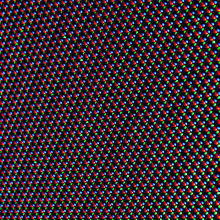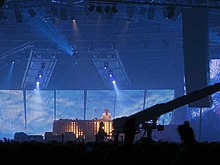LED display


A LED display is a flat panel display that uses an array of light-emitting diodes (LEDs) as pixels for a video display. Their brightness allows them to be used outdoors where they are visible in the sun for store signs and billboards. In recent years, they have also become commonly used in destination signs on public transport vehicles, as well as variable-message signs on highways. LED displays are capable of providing general illumination in addition to visual display, as when used for stage lighting or other decorative (as opposed to informational) purposes. LED displays can offer higher contrast ratios than a projector and are thus an alternative to traditional projection screens, and they can be used for large, uninterrupted (without a visible grid arising from the bezels of individual displays) video walls. microLED displays are LED displays with smaller LEDs, which poses significant development challenges.[1]

Their use in cinemas to replace projectors and projection screens has been explored.[2][3][4]
History
[edit]Light-emitting diodes (LEDs) came into existence in 1962 and were primarily red in color for the first decade. The first practical LED was invented by Nick Holonyak in 1962 while he was at General Electric.[5]
The first practical LED display was developed at Hewlett-Packard (HP) and introduced in 1968.[6] Its development was led by Howard C. Borden and Gerald P. Pighini at HP Associates and HP Labs, who had engaged in research and development (R&D) on practical LEDs between 1962 and 1968. In February 1969, they introduced the HP Model 5082-7000 Numeric Indicator.[7] It was the first LED device to use integrated circuit (integrated LED circuit) technology,[7] and the first intelligent LED display, making it a revolution in digital display technology, replacing the Nixie tube and becoming the basis for later LED displays.[8]
Early models were monochromatic by design. The efficient Blue LED completing the color triad did not commercially arrive until the late 1980s.[1]
In the late 1980s, Aluminium Indium Gallium Phosphide LEDs arrived. They provided an efficient source of red and amber and were used in information displays. However, it was still impossible to achieve full colour. The available "green" was hardly green at all – mostly yellow, and an early blue had excessively high power consumption. It was only when Shuji Nakamura, then at Nichia Chemical, announced the development of the blue (and later green) LED based on Indium Gallium Nitride, that possibilities opened for big LED video displays.
The entire idea of what could be done with LED was given an early shake up by Mark Fisher's design for U2's PopMart Tour of 1997. He realized that with long viewing distances, wide pixel spacing could be used to achieve very large images, especially if viewed at night. The system had to be suitable for touring so an open mesh arrangement that could be rolled up for transport was used. The whole display was 52m (170ft) wide and 17m (56ft) high. It had a total of 150,000 pixels. The company that supplied the LED pixels and their driving system, SACO Technologies of Montreal, had never engineered a video system before, previously building mimic panels for power station control rooms.
Today, large displays use high-brightness diodes to generate a wide spectrum of colors. It took three decades and organic light-emitting diodes for Sony to introduce an OLED TV, the Sony XEL-1 OLED screen which was marketed in 2009. Later, at CES 2012, Sony presented Crystal LED, a TV with a true LED-display, in which LEDs are used to produce actual images rather than acting as backlighting for other types of display, as in LED-backlit LCDs which are commonly marketed as LED TVs.
Large video-capable screens
[edit]The 2011 UEFA Champions League Final match between Manchester United and Barcelona was broadcast live in 3D format in Gothenburg (Sweden), on an EKTA screen. It had a refresh rate of 100 Hz, a diagonal of 7.11 m (23 ft 3.92 in) and a display area of 6.192×3.483 m, and was listed in the Guinness Book of Records as the largest LED 3D TV.[9][10]
Development
[edit]Early prototypes
[edit]A claim for the 'first all-LED flat panel television screen' is presented in this section. It was possibly developed, demonstrated and documented by James P. Mitchell in 1977. Initial public recognition came from the Westinghouse Educational Foundation Science Talent Search group, a Science Service organization.[11][verification needed] The paper entry was named in the "Honors Group" publicized to universities on January 25, 1978.[12] The paper was subsequently invited and presented at the Iowa Academy of Science at the University of Northern Iowa.[13][14] The operational prototype was displayed at the Eastern Iowa SEF[15] on March 18 and obtained a top "Physical Sciences" award and IEEE recognition. The project was again displayed at the 29th International SEF at Anaheim Ca. Convention Center on May 8–10.[16] The ¼-inch thin miniature flat panel modular prototype, scientific paper, and full screen (tiled LED matrix) schematic with video interface was displayed at this event.[17][18] It received awards by NASA[19] and General Motors Corporation.[20][21][22] This project marked some of the earliest progress towards the replacement of the 70+-year-old high-voltage analog CRT system (cathode-ray tube technology) with a digital x-y scanned LED matrix driven with an NTSC television RF video format. Mitchell's paper and operational prototype projected the future replacement of CRTs and included foreseen applications to battery operated devices due to the advantages of low power consumption. Displacement of the electromagnetic scan systems included the removal of inductive deflection, electron beam and color convergence circuits and has been a significant achievement. The unique properties of the light-emitting diode as an emissive device simplify matrix scanning complexity and have helped the modern television adapt to digital communications and shrink into its current thin form factor.
The 1977 model was monochromatic by design.
Recent developments
[edit]MicroLED displays are currently under development by numerous major corporations such as Sony, Apple, Samsung, and LG.
These displays are easily scalable, and offer a more streamlined production process. However, production costs remains a limiting factor.[23]

See also
[edit]References
[edit]- ^ a b Reynolds, Daniel (2021-10-28). "An Introductory Guide to LED Display Technology and its Uses & Benefits". Dynamo LED Displays. Archived from the original on 2022-02-19. Retrieved 2022-02-19.
- ^ "LG and Odeon Multicines Open World's First 100% LED Cinema with Dolby Atmos in Madrid - Boxoffice". www.boxofficepro.com. 2023-11-27. Retrieved 2024-08-01.
- ^ Giardina, Carolyn (2023-04-15). "LED Screens for Theaters: Is the Buzzy Tech Worth the Cost?". The Hollywood Reporter. Retrieved 2024-08-01.
- ^ "'Word-first' acoustic transparent LED cinema screen debuts". AV Magazine. Retrieved 2024-08-01.
- ^ "Inventor of Long-Lasting, Low-Heat Light Source Awarded $500,000 Lemelson-MIT Prize for Invention". Washington, D.C. Massachusetts Institute of Technology. April 21, 2004. Archived from the original on October 9, 2011. Retrieved December 21, 2011.
- ^ Kramer, Bernhard (2003). Advances in Solid State Physics. Springer Science & Business Media. p. 40. ISBN 9783540401506.
- ^ a b Borden, Howard C.; Pighini, Gerald P. (February 1969). "Solid-State Displays" (PDF). Hewlett-Packard Journal: 2–12.
- ^ "Hewlett-Packard 5082-7000". The Vintage Technology Association. Archived from the original on 17 November 2014. Retrieved 15 August 2019.
- ^ EKTA’s Ukrainian produced 3D Led TV makes The Guinness Book of World Records Archived 2011-10-18 at the Wayback Machine, www.ekta-led.com
- ^ Largest LED 3D TV. guinnessworldrecords.com
- ^ "Science Service 1719 N Street N.W. Washington, D.C. 20036". 1978. Archived from the original on 2016-04-28. Retrieved 2016-05-03.
- ^ The honors group STS projects were released for publication January 25, 1978 to "all leading universities and colleges of the United States utilizing a list furnished for the American Council on Education".
- ^ This event was held April 21–22 in Cedar Falls, Iowa at the UNI campus
- ^ Mitchell's abstract title "Light Emitting Diode Television Screen" was published in the Honors Group of the 37th Annual Science Talent Search for the Westinghouse Science Scholarship and Awards in 1978, this qualified Mitchell for the UNI paper presentation that followed
- ^ "EISEF - Web - Home Page". www.eisef.org. Retrieved 2024-08-01.
- ^ "EISEF - Web - Senior Champions by Year". www.eisef.org. Retrieved 2024-08-01.
- ^ Project was viewed by ISEF judges, Los Angeles area college professors, the 1977 president of the national chapter of the IEEE, and also included a public viewing.
- ^ The prototype and scientific paper "Light Emitting Diode Television Screen" was part of exhibit #635.
- ^ 29th ISEF "Announcement of Awards", p. 4, May 13, 1978, published by the Science Service, 1719 N Street Washington D.C. 20036.
- ^ 3rd Grand GM ISEF award, GM was also the corporate sponsor of the 1978 Science Service event. 1978 29th Annual ISEF "Announcement of Awards", p. 5, (note: Intel Corporation is the current sponsor of this event).
- ^ Mitchell's modular LED x-y (horizontally and vertically digitally scanned array system) was cited in the 29th International Science and Engineering Exposition "book of abstracts", p. 97, published by the "Science Service", Washington D.C. May 1978.
- ^ Mitchell continued to display the fully operational prototype including May 6 at the University of Northern Iowa Industrial Arts event capturing another first award. Additional recognition included letters from Iowa senators John Culver and Dick Clark, the Air Force, the Army, college and university letters acknowledging the Westinghouse STS paper entry.
- ^ says, Sylvain Muckenhirn (2019-05-29). "MicroLEDs: The Next Revolution In Displays?". Semiconductor Engineering. Retrieved 2019-06-27.
External links
[edit] Media related to LED displays at Wikimedia Commons
Media related to LED displays at Wikimedia Commons
